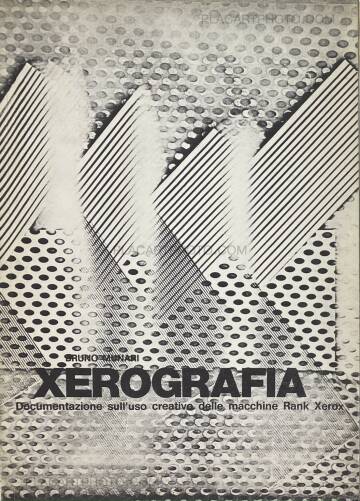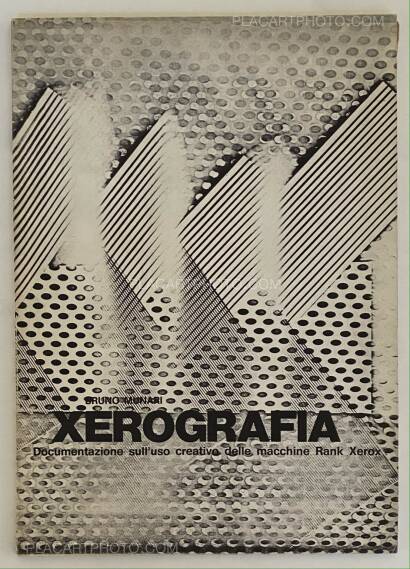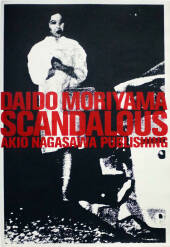XEROGRAFIA

Bruno Munari
XEROGRAFIA
Photographs: Bruno Munari
Publisher: self published
52 pages
Year: 1970
Comments: Softcover, numerous b&w illustrations, preserved in very good condition! Rare artist's book!
Book produced on the occasion of the XXXV Venice International Art Biennale, 1970. Munari was one of the first artists to use these machines creatively. "The results of the most advanced scientific and technological research, although generally understood with very different functions, can offer unexpected means to the creative operation, and open up a rich and fascinating discourse in the area of artistic research".
Focusing on Munari’s experiments with the Xerox 914 Machine, which began in 1963 and would continue throughout his entire career, the presentation brings a selection of works documented in his seminal book “Xerografia: Documentazione sull’uso creativo delle macchine Rank Xerox (Xerography: Documentation of the creative use of the machine Rank Xerox)”. Published in conjunction with Munari’s participation in the 1970 Venice Biennale, to which Munari contributed a Xerox machine to an experimental laboratory within the Biennale, the book provides instructions on the many ways to subvert the commercial machine’s function to create original images and artworks. Ranging from abstract to figurative, Munari’s Xerox works distort the original subject as he moved images across the devices surface for the duration of the scanning process.
In his prolific, 70-year career, Bruno Munari became known for various contributions to art, industrial design, film, architecture, art theory, and technology—including an early model of the portable slide-projector. He liked to (falsely) claim that his name meant “to make something out of nothing” in Japanese. Munari’s principles and beliefs were built upon his early involvement in the Futurist movement, which he joined at the age of 19 using the pseudonym “Bum.” During the 1930s, Munari began to move towards Constructivism, particularly with his kinetic sculptures, Useless Machines (begun 1933), meant to transform or complicate their surrounding environments. Throughout his career, Munari was captivated by both a sense of whimsy and the manipulation of artificial light. After World War II, Munari also developed radical innovation in graphics, typography, and book publishing, through the latter creating pieces he would call Useless Books.












more books tagged »italian« | >> see all
-
Panopticon (SIGNED, edt of 130)
by Riccardo Dogana
Euro 70 -
Megalopolis: Los Angeles, Mexico, San Paolo
by Paolo Gasparini
sold -
PERSONA (SIGNED AND NUMBERED, edt of 15)
by Laura Rodari
Euro 800 -
1994-2001
by Lorenzo Castore
sold -
Taedium
by Attilio Solzi
Euro 22 -
a Storybook Life
by Philip-Lorca Dicorcia
sold
more books tagged »abstract« | >> see all
-
Abstracts
by Collective
sold -
Z.z.(t) vol 2 (Shrinkwrap)
by Dirk Braeckman
sold -
INDAGO
by Yurian Quintanas Nobel
sold -
Sediment (Signed and Numbered to 80)
by Daisuke Yokota
sold -
Quiulacocha (With print)
by Marco Garro
Euro 100 -
100 Bilder (SIGNED by all)
by Collective
sold
more books tagged »xerox« | >> see all
-
Starve A Fever (Edt of 50)
by Agathe Rouselle
sold -
PROBLEMS PROBLEMS PROBLEMS... SOLUTION (EDT of 25)!
by Charlie Tallott
sold -
OKINAWA 1973
by Various photographers
price on request -
SET OF LINGER (SIGNED) + TEIKAI + IMMERSE (SIGNED)
by Daisuke Yokota
sold -
THE UNCANNY
by Jim Reed
sold -
IMMERSE
by Daisuke Yokota
Euro 250
more books tagged »Artist's book« | >> see all
-
Voyeur
by Emma Souharce
sold -
Meat (ARTIST'S EDITION 3/5)
by Olivier Pin-Fat
Euro 3000 -
DE-COLLAGE 6
by Collective
sold -
Birds of the West indies
by Taryn Simon
sold -
CINÉ-MIETTES (SIGNED LTD EDT OF 50)
by Daniel Quesney
Euro 260 -
Traces (EDT OF 10)
by Alain Reichling
sold
Books from the Virtual Bookshelf josefchladek.com



























;jpg)



 Facebook
Facebook Instagram
Instagram